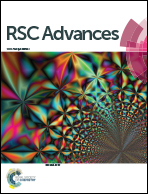Antifouling behavior of chitosan adorned zinc oxide nanorods
Abstract
Chitosan adorned zinc oxide nanorods (CAZO NRs) were synthesized by a chemical conversion method. The synthesis was carried out by the conversion of chitosan biopolymer capped zinc(II) ions using a sodium hydroxide solution under atmospheric conditions at 70 °C. The resulting CAZO NRs were investigated by UV-Visible spectroscopy, Fourier transform infra-red spectroscopy, Raman spectroscopy, X-ray diffraction, X-ray photoelectron spectroscopy, photoluminescence spectroscopy, field emission scanning electron microscopy and high resolution transmission electron microscopy. The CAZO NRs are mixed with commercial paints (polyurethane clear, polyurethane white and acrylic emulsion) and applied on three different surfaces (wood, mild steel and cement slab panels). The hydrophilicity and uniform surface smoothness of CAZO nanopaint coated panels were analyzed by water contact angle measurement. These panels were investigated for their antifouling behavior against three different green and marine algae viz. Arthrospira, Chlorella and Amphora. The CAZO NRs exhibit 75–90% antifouling efficiency against the growth of algae.


 Please wait while we load your content...
Please wait while we load your content...